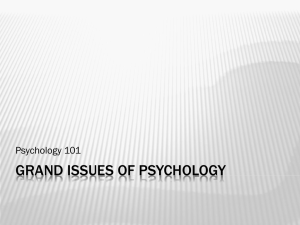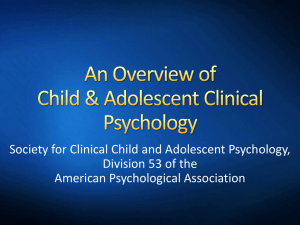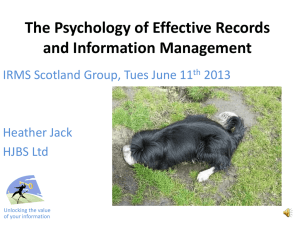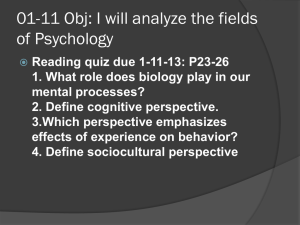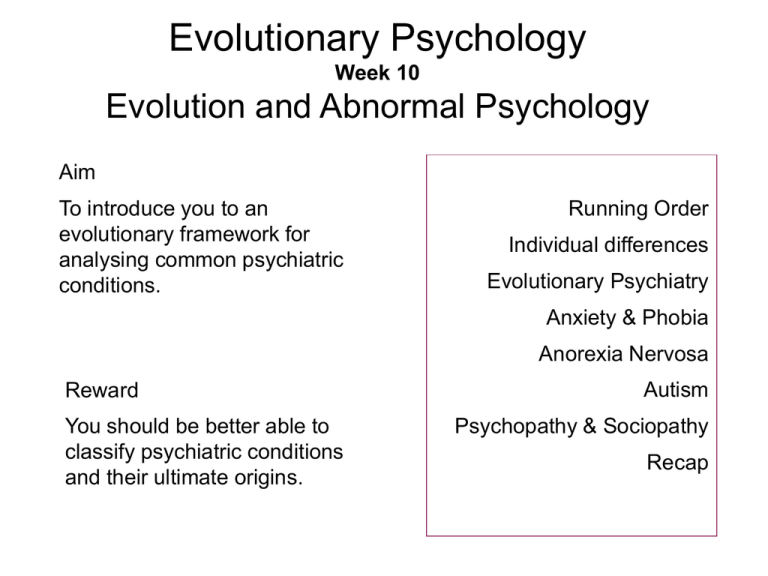
Evolutionary Psychology
Week 10
Evolution and Abnormal Psychology
Aim
To introduce you to an
evolutionary framework for
analysing common psychiatric
conditions.
Running Order
Individual differences
Evolutionary Psychiatry
Anxiety & Phobia
Anorexia Nervosa
Reward
You should be better able to
classify psychiatric conditions
and their ultimate origins.
Autism
Psychopathy & Sociopathy
Recap
Evolutionary Psychology
Week 10 - Evolution and Abnormal Psychology
Types of Mental Disorder based on an evolutionary analysis
• Distributed abnormalities – the result of abnormal expression of
adaptive states e.g. anxiety.
• Mismatch abnormalities – the result of a ‘normal’ mind in an
abnormal environment e.g. anorexia nervosa.
• Phylogenetic abnormalities – the result of genetic or epigenetic
problems e.g. autism.
• Frequency dependent abnormalities – the result of frequency
selection or social conditions eliciting marginal strategies e.g.
psychopathy and sociopathy.
Evolutionary Psychology
Week 10 - Evolution and Abnormal Psychology
Anxiety (fears and phobias): a (suite of) distributed abnormalities?
def:- anxiety; a vague, unpleasant emotional state characterised by
apprehension, dread, and unfocused distress.
The basic idea is that anxiety & phobic disorders are extreme versions
of adaptive responses.
Anxiety is to be distinguished from
fear:- this, as a form of anxiety, is identifiably attached to a person,
place or circumstance.
phobia:- the etymology is the Greek term for fear; current usage adds
the caveat that a phobia is persistent and irrational.
Evolutionary Psychology
Week 10 - Evolution and Abnormal Psychology
Anxiety (fears and phobias): a (suite of) distributed abnormalities?
General anxiety has evolved to deal with the general uncertainty of the
environment. It can be viewed as • A form of worry: this could be real, imagined or habitual
(developmental).
• A form of vigilance: this could be calibrated in accordance with desired
outcomes.
Specific anxieties have evolved to give selective protection against
specific dangers
(snakes – spiders – heights - darkness – blood – strangers - social
scrutiny – separation - leaving the home range – open spaces – closed
spaces – social rejection).
Evolutionary Psychology
Week 10 - Evolution and Abnormal Psychology
Anxiety (fears and phobias): a (suite of) distributed abnormalities?
Most phobias are exaggerations of the basic anxiety underlying each &
have biological markers.
•
Increased heart beat - increases blood flow to muscles & lactic acid
rinsing.
•
Increased respiration - increases oxygen content in blood.
•
Muscle contraction - a warm-up in preparation for energetic movement.
•
Increased catabolism - the endocrine system speeds up the break down
of complex molecules resulting in increase blood sugar.
•
Psychological fixation on avoidance - thinking is wholly focused on
escape.
•
Direction of escape - home and kin.
Evolutionary Psychology
Week 10 - Evolution and Abnormal Psychology
Anxiety (fears and phobias): a (suite of) distributed abnormalities?
Anxieties are designed to facilitate escape from life-threatening
danger, phobias are the result of ...
• An excess of the anxiety provoking stimuli – this can lead to the
anxiety being permanently ‘on’ and attached to a salient example
of the stimuli.
• The misfiring of the underlying psychological mechanism.
Evolutionary Psychology
Week 10 - Evolution and Abnormal Psychology
Anorexia Nervosa: a mismatch abnormality?
The uncertain future hypothesis
The idea is that weight manipulation is a reliable way of turning off
menstruation and is used when the reproductive future looks
uncertain.
• Insufficient fat reserves at the onset of pregnancy seriously
reduce the chances of a positive outcome for mother and child.
• Insufficient fat reserves may be taken to have been a frequent
occurrence under ancestral conditions.
• Insufficient fat reserves has evolved into an optional strategy for
females.
• This strategy is deployed when the reproductive future looks
uncertain – it acts as a form of contraception.
Evolutionary Psychology
Week 9 - Abnormal Psychology
Anorexia Nervosa: a mismatch abnormality?
The uncertain future hypothesis
This leads to one main multifaceted prediction: Any perceived
rupture to ancestrally normal/ideal social conditions required for a
successful outcome to pregnancy and rearing to puberty could
trigger desire for weight loss. These include ...
• Low self esteem disrupting the ability to confidently calculate mate
value.
• Inability to confidently estimate male intentions – could be
triggered by sexual abuse.
• Actual or perceived inadequacy of social relations with same sex
peers.
• Anxiety/pessimism about the stability of the social environment.
Evolutionary Psychology
Week 10 - Evolution and Abnormal Psychology
Anorexia Nervosa: a mismatch abnormality?
The female intra-sexual competition hypothesis
The basic idea is that young females adjust their weight to undercut
a local norm & this norm has steadily decreased over the
twentieth century pushing females into anorexia/bulimia.
• Nubility correlates with body shape e.g. size and distribution of
fat deposits.
• Size and distribution of fat deposits correlates with number of
offspring.
• Nubility is the single most important attractor of males.
• Females will seek to retain/enhance body shape as an indicator
of nubility against a local norm.
This leads to four predictions ...
Evolutionary Psychology
Week 10 - Evolution and Abnormal Psychology
Anorexia Nervosa: a mismatch abnormality?
The female intra-sexual competition hypothesis
• Those who suffer eating disorders should be most
concerned/obsessed with body shape (especially the midrift).
• Eating disorders should be most prevalent in societies
where nubile body shapes are retained by virtue of low birth
rates.
• Eating disorders should be most prevalent in societies
where nubile body shapes presented as ideal during
development.
• Because nubility is a sex-typed female predictor of RV,
eating disorders should be most prevalent amongst
females – the most lopsided sex ration known to psychiatry
at 9.5: 1.
Evolutionary Psychology
Week 10 - Evolution and Abnormal Psychology
Autism and the ‘Theory Theory’: a phylogenetic abnormality?
The basic idea is that the autistic cannot form normal social relations
because he/she doesn’t understand that others have mental states.
Mental states (a.k.a. ‘intentional states’) have the property of
• being about something – they have content
• attached to content is an attitude toward it – it is liked/desired.
e.g. one can have a mental state whereupon one understands/cognises that it
is raining and hold an attitude about the fact.
To have a ‘propositional attitude’, one must add a third property to mental
states - that they are held by a specifiable other(s).
e.g. Joshmo understands that it is raining and is unhappy about the fact.
Such ascriptions of mental states are both how we understand and predict the
behaviour of others.
e.g. Joshmo’s act of running to a shop doorway is explicable in terms of his
understanding that it is raining and his unhappiness about the fact.
Evolutionary Psychology
Week 10 - Evolution and Abnormal Psychology
Autism and the ‘Theory Theory’: a phylogenetic abnormality?
• Those who suffer from autism do not form theories of other
minds via sequences of intentional states.
• Baron-Cohen calls this ‘mind blindness’.
• The reason we might class autism as a ‘phylogenetic’ disorder
is because the condition is atavistic.
N.B. The condition that we call ‘autism’ was given its name by
Leo Kanner in 1943. Since then and until recently it occurred
c.once in every 2500 births, and is c.4 times as common in males
than females.
Evolutionary Psychology
Week 10 - Evolution and Abnormal Psychology
Psychopathy and Sociopathy
Sociopathy has come to be an alternative term to psychopathy
because;
• Constraint regarding the use of the terms ‘psychopathy’ and
‘psychopath’ had been lost.
• It reflects the ‘social turn’ in psychiatry prompted by the antipsychiatry movement in the 60’s.
• NB It is being eclipsed by the term ‘anti-social personality’.
• However, a more recent distinction is being forged between ...
Evolutionary Psychology
Week 10 - Evolution and Abnormal Psychology
Psychopathy/Sociopathy
Psychopaths
Sociopaths
primary psychopathy
secondary psychopathy
The idea is that individuals
carrying a key genotypic
similarity coding for a
personality that behaves
similarly in different
environments.
‘Mind illness’
The idea is that individuals of
different genotypes respond
similarly to key environmental
stimuli in the course of
development.
‘Social illness’
Evolutionary Psychology
Week 10 - Evolution and Abnormal Psychology
Psychopathy/Sociopathy: a frequency dependent
abnormality?
Psychopaths: ‘In-group’ behavioural similarities include ...
•
Apparent absence of socially specific emotions: e.g. remorse, shame,
guilt, sympathy, empathy.
•
Apparent absence of fear and/or non-responsiveness to fear as a
conditioning tool.
•
Profound egocentrism - the manifestation being unreliable &/or
irresponsible &/or impulsive social behaviour.
•
Normal IQ and normal theory of mind.
•
Difficulty/inability to form lasting, equitable social bonds and
relationships.
•
Capacity to think clearly about situations without the clutter of
considerations about the effect and affect on others – this may
heighten the ability to manipulate others.
Evolutionary Psychology
Week 10 - Evolution and Abnormal Psychology
Psychopathy/Sociopathy: a frequency dependent
abnormality?
If it has a genetic basis, the proportion of primary psychopaths should
not vary as a proportion of the population or in response to (relative to
gene pool change) cultural change/SES background.
• Baseline frequency appears to be constant over time and place.
• Equally likely to come from all socio-economic backgrounds.
• Behaviours are robust against rehabilitation.
Evolutionary Psychology
Week 10 - Evolution and Abnormal Psychology
Psychopathy/Sociopathy: frequency dependent abnormality?
Sociopathy
Predictions
Risks factors include
• disruptive family life
including father absence;
• inconsistent feedback;
• poor pro-social behavioural
models;
• poverty e.g. low income,
large family size, poor
housing.
• Proportion of secondary
psychopaths does & will vary.
• The strategy is sensitive to
frequency dependent nature of
success for cheating.
• Frequent but not emotionless
cheating – they are susceptible
to the stabilising effect of an
affectionate/equitable bond.
• Cheating tied to age, hormone
levels, and competitive status.


